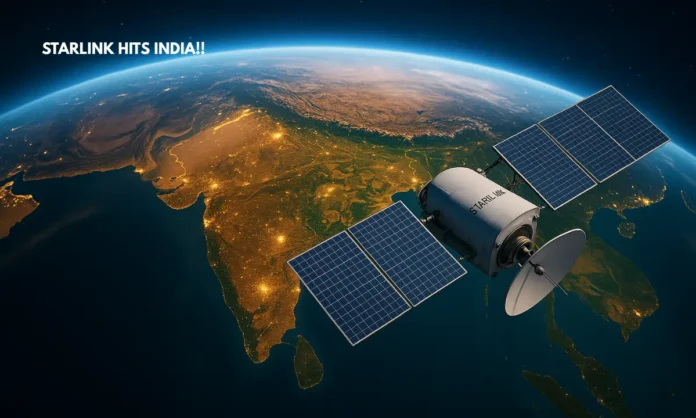SUMMARY
- Starlink plans to launch 700–750 LEO satellites in India with a capex of ₹8,000 crore and major implications for local telecoms.
- Subscriber cost could fall from ₹11,250 to ₹450/month with scale, highlighting sharp operating leverage potential.
- Direct-to-cell tech faces performance challenges, but Starlink eyes early disruption in B2C, B2B, and B2G segments.
India’s Satellite Leap: A New Frontier in the Internet Wars
India’s internet infrastructure is on the brink of a potential shake-up as Elon Musk’s Starlink prepares its entry. With over 700 low earth orbit (LEO) satellites planned and capex of ₹8,000 crore, SpaceX’s satellite arm is not just testing Indian waters—it’s preparing to orbit them.
At a recent expert panel hosted by JM Financial, analysts explored how Starlink could reshape India’s connectivity landscape. The discussion offered a rare glimpse into the economic viability of satellite internet in one of the world’s largest data consumption markets. But behind the buzz lies a deeper question: Can Starlink upend the home broadband empires built by Reliance Jio and Bharti Airtel?
From hardware cost hurdles and subscriber scale dynamics to direct-to-cell ambitions and regulatory bottlenecks, the panel broke down the challenges Starlink must overcome—and the ripple effects on Indian telecom giants. The conversation also hinted at a bigger play in B2B and B2G partnerships, where the lines between public service and private profit begin to blur.
Starlink is growing very fast. 🚀
— DogeDesigner (@cb_doge) July 15, 2025
• 6M+ customers.
• Available in 140 countries.
• ~200 Mbps median peak-hour downlink 🇺🇸
• 25.7 ms median peak-hour latency 🇺🇸
• ~450 Tbps cumulative capacity launched
• 42 new countries & 2.7M active users added in past year pic.twitter.com/iMquazJIKe
The Economics of Orbit: Starlink’s Cost Challenge in India
- Starlink’s India deployment will involve 700–750 satellites, each costing ~$1 million.
- Capex projected at ₹8,000 crore; annual opex estimated at ₹350 crore.
- Initial per-user cost could be ₹11,250/month—viable only with large-scale adoption.
Starlink’s India ambitions aren’t cheap. To blanket the country with LEO satellite coverage, the company plans to deploy 700–750 satellites, with a combined capital cost nearing ₹8,000 crore. Each unit is expected to serve reliably for 7–8 years, offering a significant infrastructure play.
But the economics hinge on scale. With customer premise equipment (CPE) currently priced around $400, costs are front-loaded and prohibitive. If domestic production is ramped up, prices could be slashed by 50%, but even then, early adoption would require heavy subsidies or leasing models to ease consumer entry.
The math becomes compelling at scale: At 0.1 million users, the service costs around ₹11,250 per subscriber monthly. But if that number swells to 2.5 million, Starlink could slash that figure to ₹450—a viable consumer broadband alternative. This operating leverage, however, is more potential than promise for now.
Telecom Disruption or Niche Expansion? The Jio-Airtel Risk
- Starlink aims to offer B2C plans at $20–25/month, eventually scaling down to $10.
- Jio and Airtel could face home broadband competition; wireless businesses remain safe for now.
- Satellite broadband could change the B2B/B2G landscape more rapidly than the retail segment.
The threat to India’s telecom incumbents is nuanced. While Bharti Airtel and Reliance Jio dominate the wireless segment—with valuations heavily tied to their mobile subscriber base—Starlink is unlikely to disrupt this space in the short term. Instead, its focus is on home broadband, where the market is still fragmented and underserved in rural areas.
Introductory plans could hover around $20–25 for early adopters, with a broader rollout at $10/month—low enough to tempt users, but still high for India’s price-sensitive market. Starlink may find its footing first in B2B (enterprise) and B2G (government) applications, such as disaster zones, remote education, and defence communications.
Starlink’s model is more capital-intensive than fibre but offers greater agility. For Jio and Airtel, this means a rethink on home broadband strategies, particularly in tier-2 and tier-3 cities where fibre penetration is limited and satellite could leapfrog ground infrastructure.
Direct-to-Cell Technology: Hype or Hope?
- Starlink’s D2C technology lags behind traditional 4G/5G in speed and reliability.
- Technical maturity is expected in 3–5 years, limiting near-term disruption.
- The tech may eventually support emergency services and IoT connectivity in remote areas.
A wildcard in Starlink’s India strategy is its long-term play in direct-to-cell (D2C) connectivity. This would allow smartphones to connect directly to satellites without ground towers—a concept that could revolutionize mobile communication, especially in inaccessible terrains.
However, experts agreed that current D2C tech doesn’t match traditional 4G or 5G standards in terms of latency or reliability. Over the next 3–5 years, incremental improvements are expected, but it won’t replace tower-based infrastructure anytime soon.
Still, niche use cases—emergency rescue, IoT sensor coverage, and defence operations—could benefit from D2C early. It’s not a question of “if,” but “where” and “how fast” the gap closes.
The New Telecom Battlefield
Starlink’s expansion into India is more than just a new entrant in broadband—it’s the first shot in a larger war for infrastructure dominance in remote and underserved regions. With its model blending commercial scale and humanitarian promise, Starlink sits at the edge of both market disruption and global diplomacy.
But the outcome will depend on execution. Can Starlink manufacture CPE affordably within India? Will the government ease regulatory barriers for private satellite operators? And crucially, can Jio and Airtel counter with satellite partnerships of their own?
In a market where data is as essential as power or water, the orbiting satellites may soon redefine who owns the last mile—and who controls the digital sky.


